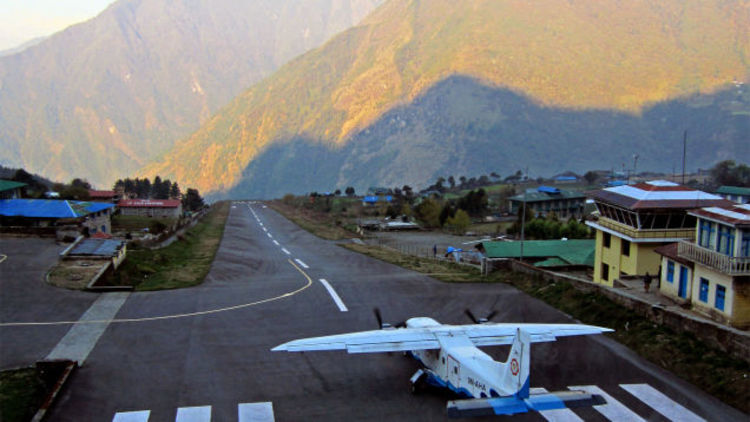Whatever it takes to keep from falling off this cliff
 Lukla airport in Nepal is one of the strangest in the world. Built to support tourism to the Himalayas, the airport has a single landing runway. What is more, the runway is only 20 m wide, 450 m long, and is followed by a 2,800 m cliff, leaving little room for error. In fact, the airport can only be used by so-called Short Takeoff and Landing planes (STOL). Helping somewhat is a 12% incline in the runway from start to finish, that planes rise through over the course of their deceleration.
Lukla airport in Nepal is one of the strangest in the world. Built to support tourism to the Himalayas, the airport has a single landing runway. What is more, the runway is only 20 m wide, 450 m long, and is followed by a 2,800 m cliff, leaving little room for error. In fact, the airport can only be used by so-called Short Takeoff and Landing planes (STOL). Helping somewhat is a 12% incline in the runway from start to finish, that planes rise through over the course of their deceleration.
Suppose a STOL plane's landing speed is 45 m/s ( 100 mph). In addition to gravity, the plane experiences a first order drag force .
How close (in meters) does the plane get to the end of the runway?
Details
- N s/m
- m/s ( Important !)
- The plane's mass is 500 kg
- The runway itself is 450 m long, i.e. if you walked from the bottom to the top, you'd walk 450 m along the runway.
- An % incline means that if you walk a distance along an incline, your rise is given by .
The answer is 7.66.
This section requires Javascript.
You are seeing this because something didn't load right. We suggest you, (a) try
refreshing the page, (b) enabling javascript if it is disabled on your browser and,
finally, (c)
loading the
non-javascript version of this page
. We're sorry about the hassle.
Let the direction "up the incline" be positive. Using Newton's 2nd law of motion. m a = − k v − m g sin θ
a can be written as v d x d v
m v d x d v = − k v − m g sin θ
Rearranging, k v + m g sin θ m v d v = − d x
Multiplying both sides by m k k v + m g sin θ k v d v = − m k d x
k v + m g sin θ k v + m g sin θ − m g sin θ d v = − m k d x
∫ v 0 1 − k v + m g sin θ m g sin θ d v = − ∫ 0 x m k d x
∫ 0 v 1 − k v + m g sin θ m g sin θ d v = ∫ 0 x m k d x
[ v − k m g sin θ ln ( k v + m g sin θ ) ] 0 v = m k x
x = k m ( v − k m g sin θ ln ( k v + m g sin θ ) + k m g sin θ ln ( m g sin θ ) )
x = k m ( v + k m g sin θ ln ( k v + m g sin θ m g sin θ ) ) Now we substitute:
m = 5 0 0 k g , k = 2 0 N. s/m , v = 4 5 ms − 1 g = 9 . 8 1 m s − 2 , sin θ = 0 . 1 2
We get x ≈ 4 4 2 . 3 3 8 m , which means the plane got 4 5 0 − 4 4 2 . 3 3 8 ≈ 7 . 6 6 m from the runway.